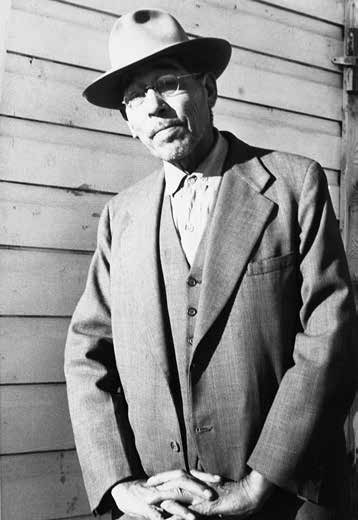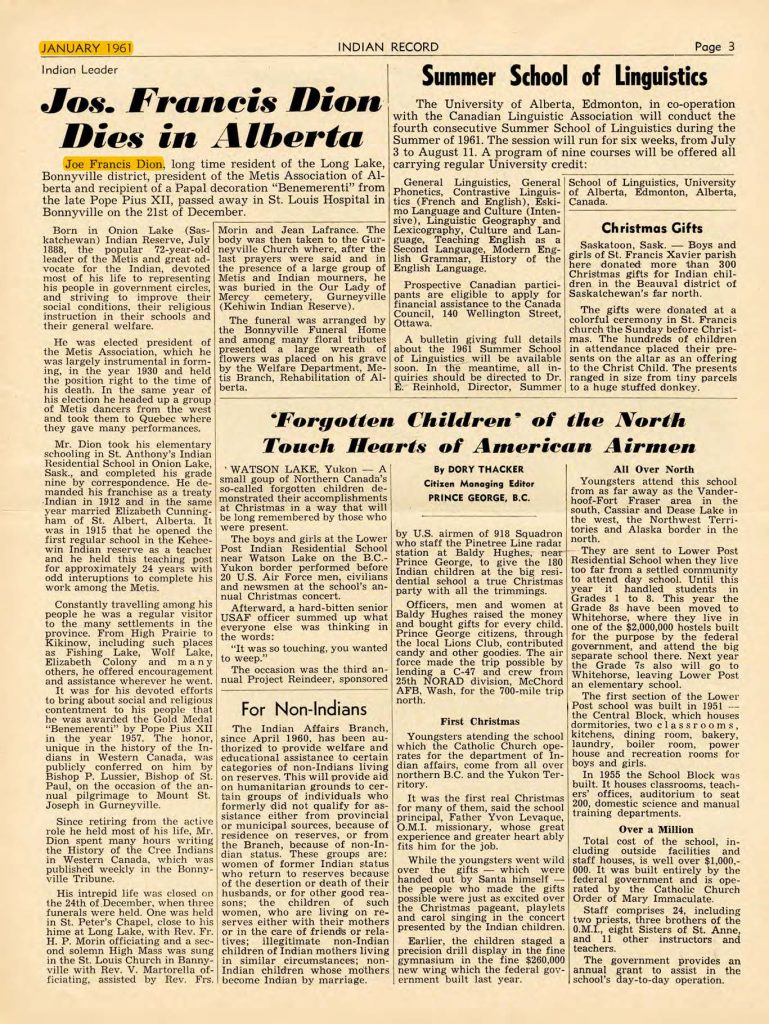Joseph Dion
 Joseph Dion was raised on the Onion Lake Reserve in the 1890s. At first, he went to the day school, but, not long after he started attending, the school burned down.
Joseph Dion was raised on the Onion Lake Reserve in the 1890s. At first, he went to the day school, but, not long after he started attending, the school burned down.
Referring to the school policy of assigning each student a number, Dion wrote,
“They gave me No. 7 as my brand, so I was one of the very first in the Onion Lake R.C. Boarding School. William Smith was the first to enter, hence his number was one. Maggie Delaney, who later married a clerk of the Hudson’s Bay store, A. L. N. Martineau, was the first girl to be enrolled.”69
He had vivid memories of the work done by the staff. Sister St. Olivier, for example, not only did the cooking, but also was in charge of seeing that the cows were milked, the chickens fed, and the supplies purchased.
“The baking alone was quite a chore. The homemade oven had to be fired a long time before it was ready, then all the coals and ashes raked out, and the pans of dough hauled at least 200 feet from the kitchen where the setting and kneading had been done. Oh, yes, the cook had to run to the church three times a day to ring the bell; and this was at seven o’clock, at twelve and six sharp.”70
Classes were held in a log house that was over 90 metres from the boarding house. In Dion’s recollection, Brother Vermet, the priest in charge of the dormitory, often threatened to use his thick leather belt on the boys, but, in the end, always let them off with a scolding. When the boys were not in class, they spent much of their time sawing and splitting firewood. “This was carried by the armful to the kitchen and sister’s house, to the school and bakery.”71 The only holiday he could recall was Dominion Day, when the students were allowed to go home from 8:00 a.m. to 7:00 p.m.72
Disease cast a long shadow over his school days. Four of his siblings died of diphtheria. Dion attributed his survival to the care he received from the sisters in the school. “They pulled us successfully through several epidemics like measles, chicken pox and scarlet fever, but they were practically helpless against the scourge of TB.”
The nine years of my happy school life were marred by the occasional death among the children. I began to notice early in life that the disease of the lungs, the Indian term for TB, was making inroads in the ranks of our young people. My schoolmates and I were not long in concluding that the lung sickness was fatal, hence as soon as we saw or heard of someone spitting blood, we immediately branded him for the grave. He had consumption: he had to die.73
His good friend Lazare was one of the students so stricken. “His bed in our dormitory was next to mine and I could hear him at all times of the night coughing and tossing around while he gasped for breath, yet he never whimpered. As the boy got worse and weaker the sisters moved him to their own house where one of them watched over him continually. How those nuns could ever stand the ordeal is beyond belief for there were but a very few of them and each one had a very heavy list of daily duties to perform. At his request I was permitted to visit the boy occasionally. He was no longer afraid: in fact he spoke quite freely about going, if only he could see mommy and dad before he left.”74
Dion left the school at the age of 15 with a Grade 8 education.75 He later became a day school teacher at Kehiwin’s Reserve. The school was little more than a shack, 16 x 18 feet (4.8 by 5.5 metres) in diameter.76 The federal government provided next to nothing in the way of supplies. “Six reversible heavy cardboard charts, four by two feet in size graced three walls of the buildings. These charts, sent to us by the Sisters at Onion Lake, proved to be our pictorial mainstay for several years. A few picture books completed the outfit. Nine pamphlets containing instructions to teachers advised in part that all pupils were to be registered, ages given, and number of days attendance of each pupil recorded. There was, however, no register, nor writing paper and pencils for use of the teacher.”77After three years, he quit in frustration, although he went back to teaching in 1921.78 (Vol 1, Part 1, pp. 181-183)
